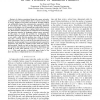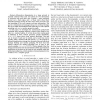65 search results - page 9 / 13 » The cover time of random geometric graphs |
ICC
2008
IEEE
15 years 6 months ago
2008
IEEE
—In battery-constrained large-scale sensor networks, nodes are prone to random failures due to various reasons, such as energy depletion and hostile environment. Random failures ...
INFOCOM
2011
IEEE
14 years 3 months ago
2011
IEEE
—Information dissemination in a large network is typically achieved when each user shares its own information or resources with each other user. Consider n users randomly located...
110
click to vote
TMC
2011
14 years 6 months ago
2011
—We propose a method to compute a probably approximately correct (PAC) normalized histogram of observations with a refresh rate of Âð1Þ time units per histogram sample on a ra...
TSP
2008
14 years 11 months ago
2008
Gossip algorithms for distributed computation are attractive due to their simplicity, distributed nature, and robustness in noisy and uncertain environments. However, using standa...
CORR
2004
Springer
14 years 11 months ago
2004
Springer
An optimization problem that naturally arises in the study of swarm robotics is the Freeze-Tag Problem (FTP) of how to awaken a set of "asleep" robots, by having an awak...


